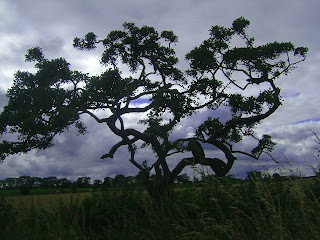The 2.5 mile stretch of line from the main Fraserburgh Mintlaw (A952) road to Longside forms a pleasant but not particularly interesting walk. Unfortunately, the tranquility of the walk is spoilt by the noise of traffic from the Longside Peterhead (A950) road which follows the Line closely along the valley of the South Ugie Water.
There are several distance posts along the first part of the line.

The woods contain an interesting mix of trees. These include rowan, elder, ash, snowberry, guelder rose, dog wood, hawthorn, silver birch, cherry and the occasional conifer. There is a great sprawling tangle of roses which it is not possible to identify at present.
Guelder rose
An incredibly contorted hawthorn growing close to the crossing with the minor road to Moss of Longmuir

Bridge 718, close to a disused quarry, now a sawmill, retains remains of telegraph wires. This was the first railway line to be opened with telegraph wires along its entire length.
'The Howes o Buchan' refers to a distillery, Glen Ugie, in this area which had recently (1865) been converted in to a sawmill, but gives the position as being on the left of the line going towards Mintlaw
Approaching Longside the track runs through uncultivated fields which look damp and were referred to in 'The Howe o'Buchan' as being probably liable to flood. Here the line is on an embankment along which willows form a leafy tunnel. At the end of the willow tunnel there is a tangled bank which includes patches of great mullein.

First view of Longside from the Line, looking across the Ugie. Beyond the tree is the start of the 'flood plain' area
Just before Longside Station the walkway has a short diversion to enable the main road to be crossed. The steps which facilitate this are made of pink granite slabs and clearly show drill marks. This is close to Auchlee Bridge. Longside Golf Course is on the opposite bank of the river.
Beyond the bridge there is a steep embankment on the side of track furthest from the river, this is currently covered in greater bindweed and brambles. There are allotments between the track and the golf course. The station is very disappointing. Only the two overgrown platforms remain festooned in ivy leaved toadflax.
 |
| Fox and Cubs or Orange hawkweed (Hieracium aurantiacum) brightens up the bed of the line in the station |
The station platform looking towards Peterhead. The branch line to RNAS Lenabo (operational from1914-1919) ran roughly South for 3miles from slightly East of the station. Details may be found at http://www.forestry-memories.org.uk/picture/number373.asp
 |
| Looking along the platform from the East. On the North side there are large houses, the nearest with an amazing steel balcony overlooking the golf course, built close to the platform |
Along much of this stretch the line passes through the flat countryside on a shallow embankment giving views across fields to Mormond Hill. At the point from which this picture was taken it is possible, with the eye of faith, to see both the white horse and the stag at the same time. The branch line to Fraserburgh passes along the near side of the hill.



































